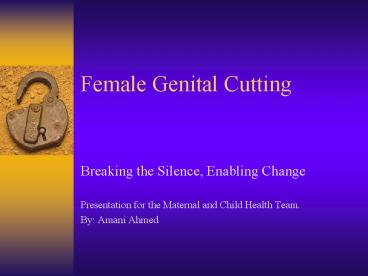Female Genital Cutting - PowerPoint PPT Presentation
1 / 15
Title:
Female Genital Cutting
Description:
circumcision as an act of violence against women in Africa. In Margaret Schuler, (Ed. ... Evaluation Guidebook Using Female Circumcision as a Case Study. New ... – PowerPoint PPT presentation
Number of Views:304
Avg rating:3.0/5.0
Title: Female Genital Cutting
1
Female Genital Cutting
- Breaking the Silence, Enabling Change
- Presentation for the Maternal and Child Health
Team. - By Amani Ahmed
2
Purpose and Objectives
- The problem of FGC is no longer the concern of
the nations that practice it. Immigrant
communities currently residing in the United
States brought the FGC as well as other cultural
practices to their host countries. - The issue present a challenge to the maternal and
child health field in general and social workers
in particular.
3
What is Female Genital Cutting
- Female Genital Cutting is the alteration of the
female genitalia. - It is a harmful cultural practice that is common
in Africa. - The practice is recognized as a maternal and
child health problem, as an issue of violence
against women and as a violation of childrens
and womens right.
4
Historical Context
- Many scholars and researchers speculated about
the origin of FGC - Some Scholars believe that FGC originated in
Africa, - Some Researchers claim that the practice started
in the Arabia Peninsula, and - Another group believe that the practice started
independently in various places.
5
Prevalence
- According to the World Health Organization
- 132 million girls and women worldwide are
affected by the practice. - Two million girls are at risk of undergoing some
type of FGC. - The practice is common in 28 African country.
Through the process of immigration the practice
was brought to Western Europe and North America.
6
Typology
- There are three common types of FGC
- Clitoridectomy
- Excision
- Infibulation
7
Physical and Psychosocial effects
- The following are some of the effects of the FGC
- Sever pain before and after the procedure
- Emotional and psychological scarring
- Vulnerability to infections
- Infertility
- Vulnerability to infections
- Pain during sexual intercourse
- Difficulties during childbirth and Maternal
morbidity
8
Justification for the Practice
- FGC eradication advocates identified these
- reasons
- Tradition
- Religion
- Sexuality
9
Early efforts to eradicate the practice
- Efforts to eradicate the practice of FCG started
as early as the colonial times. - During the 1970s and 1980s the practice started
to gain international attention. - In early 1990s, the practice was seen as a
violation of childrens and womens right.
10
The Turning Point The Egyptian Experience
- Local government in partnership with civil
society organizations. - The eradication intervention used the Positive
Deviant Approach. - Positive Deviants are individual who have stopped
or prevented the occurrence, individuals who have
stopped performing the procedure, or community
leaders who opposed the practice.
11
The Turning Point The Egyptian Experience (cont.)
- The intervention included three phases.
- In phase I Positive Deviants were identified
- During phase II Positive Deviants were
interviewed. - The last phase included analysis of gathered
data. The information was then used to formulate
a context specific and culturally sensitive
strategies.
12
Conclusion and Recommendations
- Eradication interventions need to be context
specific and culturally sensitive. - Eradication advocates should respect cultural and
religious beliefs.
13
Conclusions and recommendations (cont.)
- Intervention need to create safe environment to
break the silence. - Local communities need to be equipped with tool
to transform their communities. - Political participation and involvement of the
local communities produce positive outcome.
14
References
- Alhaleem, A.M., (1992). Claiming our bodies and
our life Exploring female - circumcision as an act of violence against women
in Africa. In Margaret Schuler, (Ed.), Freedom
from violence , Womens strategies from around
the world. New York UNIFEM. - El Dareed, A. (1982). Woman, Why do you weep?
London Zed Press - Elsaadawi, N. (1980). The Hidden face of Eve.
London Zed Press. - Izzet, S. Toubia, N. (1999). Learning about
Social Change A Research and - Evaluation Guidebook Using Female Circumcision as
a Case Study. New York RAINBOW.
15
References (Cont.)
- Rich, S. Joyce, S. (1996). Eradicating Female
Genital Mutilation Lessons for Donors.
- Washington Wallace Global Fund.
- World Bank, (1997). The World Development Report
1997 The State in a - Changing World. New York Oxford University
Press. - World Health Organization. (1997). Female Genital
Mutilation An Overview. Geneva - www.icrw.org retrieved on 11/20/04































